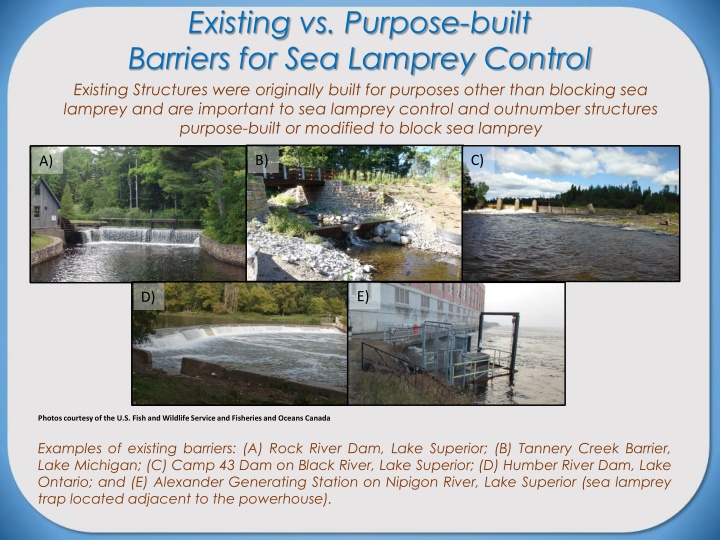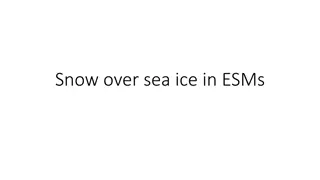Existing vs. Purpose-built Barriers for Sea Lamprey Control
Existing structures originally built for other purposes play a crucial role in sea lamprey control, outnumbering purpose-built or modified barriers. Examples include dams and barriers in the Great Lakes region. This article discusses the importance, applications, limitations, and effectiveness of existing and purpose-built barriers for managing sea lamprey populations.
Uploaded on Sep 13, 2024 | 2 Views
Download Presentation

Please find below an Image/Link to download the presentation.
The content on the website is provided AS IS for your information and personal use only. It may not be sold, licensed, or shared on other websites without obtaining consent from the author.If you encounter any issues during the download, it is possible that the publisher has removed the file from their server.
You are allowed to download the files provided on this website for personal or commercial use, subject to the condition that they are used lawfully. All files are the property of their respective owners.
The content on the website is provided AS IS for your information and personal use only. It may not be sold, licensed, or shared on other websites without obtaining consent from the author.
E N D
Presentation Transcript
Existing vs. Purpose-built Barriers for Sea Lamprey Control Existing Structures were originally built for purposes other than blocking sea lamprey and are important to sea lamprey control and outnumber structures purpose-built or modified to block sea lamprey C) B) A) E) D) Photos courtesy of the U.S. Fish and Wildlife Service and Fisheries and Oceans Canada Examples of existing barriers: (A) Rock River Dam, Lake Superior; (B) Tannery Creek Barrier, Lake Michigan; (C) Camp 43 Dam on Black River, Lake Superior; (D) Humber River Dam, Lake Ontario; and (E) Alexander Generating Station on Nipigon River, Lake Superior (sea lamprey trap located adjacent to the powerhouse).
Existing vs. Purpose-built Barriers for Sea Lamprey Control Installations 930 Existing lowermost barriers to sea lamprey movement 338 fixed-crest 55 hydropower 63 culverts/bridges 33 adjustable/seasonal 441 other 77 Purpose-built or modified barriers Most existing structures built around the turn of the century for power generation, recreation, flood control, erosion control, and transportation Applications Existing structures are owned by private individuals, companies, or other government agencies Aging infrastructure and societal desire to restore connectivity Limitations Effects Impede passage of sea lamprey and many native or non-target fishes to varying degrees Small number of barriers (mostly hydropower) have fishways The goal of these information sheets is to summarize the current knowledge regarding the effectiveness of barrier technologies and their historical use in the sea lamprey control program. Where possible, best-practice guidelines and potential applications of technologies is provided.
Fixed-Crest Barriers Water control structure that maintains an uninterrupted crest height and overhanging lip to maintain a minimum vertical drop of 45cm from the crest to the tailwater elevation Photos courtesy of the Great Lakes Fishery Commission and Fisheries and Oceans Canada Fixed-crest barrier with 61 cm of hydraulic head with (A) a vertical differential between crest height and tailwater elevation of 45 cm (18 in) and (B) no vertical differential between crest and tailwater. (A) Trail Creek, Lake Michigan, IN; (B) Carp Lake outlet, Lake Michigan, MI; (C) downstream and (D) upstream view of Still river, Lake Huron, ON; (E) Wolf River, Lake Superior, ON; and (F) Streetsville Dam, Lake Ontario, ON.
Fixed-Crest Barriers Installations 39 purpose-built 25 modified Maintain 45 cm drop up to as high a flood event as possible 15 cm overhanging lip Staging pool for jumping fish Generally suitable for sites with high riverbed slope and existing barrier Potential loss of vertical differential due to changes in watershed hydrology or lake levels Cannot block downstream movement of juvenile sea lamprey Potential for impoundment upstream Community acceptance Block upstream movement of species with limited leaping ability including adult sea lamprey Best practices Applications Limitations Effects Rainbow trout (steelhead) leaping over a fixed-crest barrier on Shelter Valley Creek, Lake Ontario, ON.
Seasonal- and Adjustable-Crest Barriers Water control structures similar to fixed-crest barriers, but crest height can be adjusted manually or automatically. Can be operated as a seasonal barrier Photos courtesy of Fisheries and Oceans Canada Sea Lamprey Control Centre Seasonal barrier on Orwell Creek, Lake Ontario, ON with (A) stoplogs out and (B) stoplogs in during sea lamprey migration. Photos courtesy of Fisheries and Oceans Canada Sea Lamprey Control Centre Big Carp River, Lake Huron, ON, inflatable crest barrier operating with (A) barrier down, (B) barrier up, (C) barrier up during flooding, and (D) Big Creek River, Lake Erie, ON, barrier with beam used to lift the crest when the control system failed. Cross-sectional view of typical Obermeyer gate with inflatable bladder. Image courtesy of the city of St. Cloud, MN (http://www.ci.stcloud.mn.us).
Seasonal- and Adjustable-Crest Barriers Installations 12 purpose-built and modified (six in US and six in Canada) Best practices Same as fixed-crest barriers: maintain 45 cm drop and 15 cm overhang Redundant power supply or alternate means to operate Operating window identified by control agent staff Negotiated staffing and schedule of operation Appropriate hydrologic analyses Same applications as fixed-crest designs Best where competing interests between fish passage, navigation, channel morphology, and flooding Mechanized systems are ill-suited for remote locations Wooden or metal stoplog designs have been more resilient than inflatable crest weirs Redundancies are required for highly mechanized systems Seasonal operation results in agreed upon risk of sea lamprey infestation Block upstream movement of fish with limited leaping ability including adult sea lamprey Non-target fish can be passed if operated seasonally Potential non-target passage with trap and sort operation Applications Limitations Effects
Weirs and Screens Structures that utilize weir panels or mesh screens to block sea lamprey while still passing water (A) Front view and side views during (B) high and (C) low flow of vertical screen barrier for trapping in Little Thessalon River, Lake Huron, ON. D) E) (D) Inclined plane sea lamprey trap installed in the Carp Lake River, Lake Michigan, MI and (E) typical design. G) F) (F) Experimental installation of a resistance weir in the Marengo River, Lake Superior, WI and (G) typical schematic of a resistance weir. Photos courtesy of Fisheries and Oceans Canada Sea Lamprey Control Centre, U.S. Fish and Wildlife Service, and Applegate and Smith (1951).
Weirs and Screens Installations No permanent installations for sea lamprey control Vertical screen barrier in Little Thessalon River, Lake Huron, ON but aided by upstream dam Resistance weir deployed in Duffins creek, Lake Ontario, ON to capture Atlantic salmon Vertical mesh screen Steel grates or racks with spacing 1.3 cm (0.5 inches) Best built at an angle to flow or in V shape Downstream inclined screens have 1.5 m of hydraulic head Resistance weirs None installed for management purposes so no best practice guidelines are available Vertical mesh screens are no longer in use as a sole barrier to sea lamprey Resistance weirs have potential for sites with a need to block and remove sea lamprey during high water events Difficult to keep screens clear of debris Early screen designs failed due to erosion Block upstream passage of adult sea lamprey and many non- target species Inclined screen traps capture recently transformed sea lamprey moving downstream Best practices Applications Limitations Effects
Velocity Barriers Water control structures that manipulate hydraulic conditions to create regions of swift flowing water that cause fish to completely exhaust their swimming capabilities thereby blocking passage Comparison of swimming performance curves of fishes found in Great Lakes tributaries. Species with greater swimming capabilities will be situated towards the right of the plot. Photo courtesy of McAuley (1996) (A) Velocity barrier installed in McIntyre Creek, Lake Erie, ON and (B) and (C) McAuley (1996) Sea Lamprey swim tests.
Velocity Barriers Installations Currently no purposefully designed velocity barriers High velocities likely contribute to sea lamprey blockage at some fixed-crest barriers when inundated No best practice guidelines available, but general design criteria and research needs include: Barrier surface treatment to prevent sea lamprey attachment Robust hydraulic analyses Improved swimming performance curves for sea lamprey and any non-target species Potential for sites were debris passage, navigation, non-target fish passage, and flood conveyance are desired Significant research on sea lamprey swimming performance needed Identifying surface treatments that prevent sea lamprey attachment without fouling is a research priority Not currently in use due to early misconceptions on required velocities and lack of success at the McIntyre River barrier Potential to differentially pass / block upstream swimming fish based on swimming performance Barriers that block strong swimming fish will block all fish with lesser abilities Best practices Applications Limitations Effects
Electrical Barriers Electrical energy applied to water is transferred to fish as a deterrent to up-or downstream movement, which can lead to taxis (forced swimming), immobilization, and possibly trauma The combined graduated field fish barrier (GFFB) and fixed-crest barrier on the Ocqueoc River, MI. Note the electrodes mounted along the barrier crest and vertical side walls. Photo courtesy of the Great Lakes Fishery Commission. Experimental application of a portable, vertical mount pulsed direct current (PDC) electrical barrier with trap in the Chocolay River, Lake Superior, MI. Photo courtesy of Johnson et al. (2016). Important Terms: Alternating Current (AC) Used in first electrical barriers, caused excessive mortality of non-target fish Pulsed Direct Current (PDC) Used in current designs, much safer, and lower non-target mortality Graduated Field Fish Barrier (GFFB) developed by Smith-Root, gradually introduces electrical field
Electrical Barriers The combined GFFB and fixed-crest barrier on the Ocqueoc River, Lake Huron, MI is the only electrical barrier used for sea lamprey control Best practices Permanent Pulsed Direct Current (PDC) electrical barriers Design generally follows manufacturer recommendations Best suited for sites with steep banks Concrete control section to embed electrodes Redundant power source Portable PDC electrical barriers None installed for management purposes so no best practice guidelines are available Applications Permanent barriers could be used at sites to block adult sea lamprey in large systems where fixed-crest barriers are not feasible Portable systems could be deployed rapidly in smaller systems Limitations Not species specific Susceptible to power failures Misconceptions regarding public safety Design features of modern electrical barriers lends it to safe operation Effects Electrical fields are non-selective Effects dependent on species, size, orientation to electrical field, and water conductivity Upstream blockage aided by flow Downstream blockage possible, but complex Installations
Other Non-Physical Barriers Technologies that use deterrent stimuli like sound, light, or chemicals (e.g., pheromones or alarm cues) to inhibit passage or guide movement Chemical cues (pheromones and alarm cues) Photo courtesy of the Great Lakes Fishery Commission. Sound and Bubbles Photo courtesy of Scott Miehls - USGS Lights Carbon dioxide Photo courtesy of Purvis et al. (1985)
Other Non-Physical Barriers Chemical Cues Apply odorants to attract (pheromones) or repel (alarm cues) sea lamprey Natural products that are species specific Difficult to identify, replicate, and outcompete natural sources Under development with some success in the field Inject CO2 into water In lab, sea lamprey avoided co2 concentrations > 85 mg/l Not species specific Many regulatory hurdles Combine sound projectors with bubble curtains to generate a wall of sound ~70-80% efficacy at guiding other fish Seemingly no effect on sea lamprey Further refinement of sea lamprey hearing capacity underway Illuminate water with continuous or strobed lights Conflicting results In the field and laboratory illuminated traps capture more sea lamprey than non-lit traps, when in close proximity In the field, lighting had no impact on sea lamprey catch at traps placed far apart Unlikely to attract or deter sea lamprey at great distances Research underway (Elvidge et al.) Carbon Dioxide Sound & Bubbles Light























